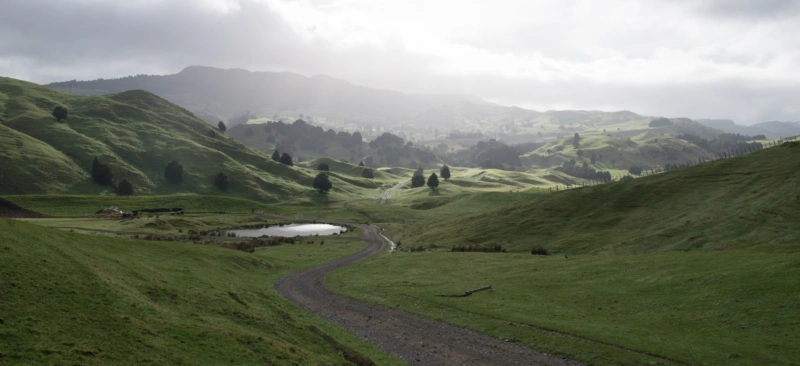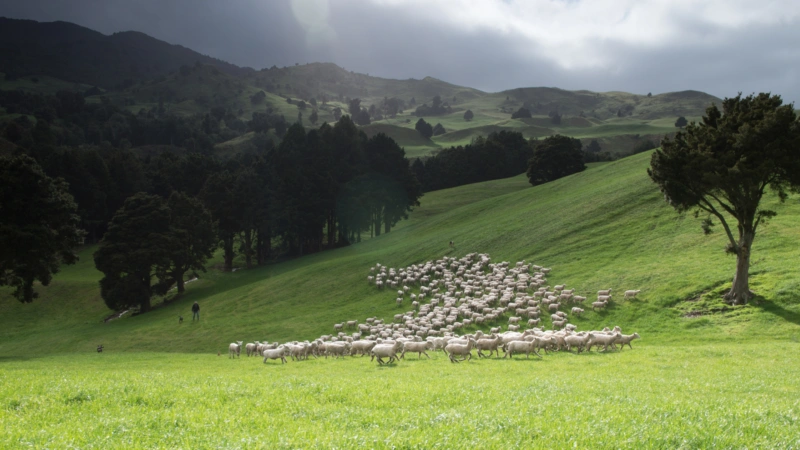Meringa Station
Sustainable Sheep & Beef Farming
Nestled 20 km from Taumarunui, Meringa Station is a high-performing 1,904-hectare hill country property (1,492 hectares effective) that has been under the ownership of Pāmu since March 2001. Managed by Graham and Tracey Sinnamon since January 2004, Meringa Station combines traditional farming with modern techniques, creating a dynamic environment rich in productivity and biodiversity. Graham and Tracey collaborate closely with farm business manager Kathryn Broomfield and a dedicated team of four employees.
Graham says Meringa Station is a stunning property, and its landscape features the Pureora Ranges at the back, the Tangamatoa Stream at the front, with lots of bush remnants between. “The infrastructure is immaculate from the fencing to the wool shed in the middle of the farm, and its mix of contour which for a King Country sheep and beef farm is fantastic.”
Farming Operations
Meringa Station remains a well-established performer in great heart, enhanced by Graham and Tracey's strategic refinements. The station includes 140 hectares of Māori lease land, 200 hectares of forestry, 250 hectares of native bush, and 100 hectares of riparian fencing.
Primarily a lamb finishing farm with 16,000 stock units, Meringa Station also engages in sheep and cattle breeding, along with a modest amount of cattle finishing. The farm carries 300 mixed-age Angus cows and also rears 200 dairy beef steers purchased annually as calves. Approximately 70% of the station's income is derived from sheep, with the remaining 30% from beef. The livestock policy is designed to mitigate the impact of drench resistance in young stock, ensuring a resilient and sustainable farming system. Meringa Station embodies farming excellence by participating in the NZ Farm Assurance Programme (NZFAP+), ensuring their prime lamb production meets high-value market standards.
To ensure the sustainability of their operations, Graham and Tracey have reduced winter cropping to prevent sediment runoff into waterways and have lowered stocking rates to reduce stress on both livestock and staff. Their innovative approach also extends to pest management and the development of new worm management systems, involving experts in parasitology and farm systems to address a serious multiple-drench resistance issue that arose in 2020. Graham and Tracey’s strategic improvements to the farm's operations, such as changing grass species to the tetraploid perennial ryegrass (Viscount) in cultivatable areas, have helped enhance lamb finishing and winter grazing capabilities.
Pāmu regional business manager Kathryn Broomfield highlights Graham and Tracey's commitment: "They have managed this farm for so long and through all the challenges we’ve faced as an industry, like keeping animals out of the waterways and reducing winter crop. It has been an ongoing journey for them the whole time they’ve been on farm."
Livestock
- 5,200 breeding ewes, finishing 20,000 lambs annually
- 550 Angus cows, with finished heifers (270 kgcw) and steers (320 kgcw)
- Finishing 200 dairy beef animals
Forages
- 70 ha lucerne platform
- 40 ha winter fodder beet and swedes
- 70 ha summer lamb finishing area
Forestry and Riparian Planting
- 162 ha of production redwood forestry
- 70 ha protected by a QEII National Trust Covenant
Commitment to Sustainability and Biodiversity
Environmental sustainability is a key focus at Meringa Station. The Sinnamons, in collaboration with Horizons Regional Council, have worked tirelessly to enhance the property's biodiversity. Meringa Station is deeply committed to environmental stewardship, actively working to enhance the farm’s natural resources and ecosystems while supporting climate change mitigation efforts. Graham and Tracey have integrated forestry into the farm's operations and protected riparian areas through extensive planting and fencing. The couple, alongside Pāmu, embraces the true spirit of guardianship (kaitiakitanga) over the land for the ongoing benefit of future generations.
The station features 162 hectares of production forestry, which is currently being re-established with 50,000 redwood cuttings from the New Zealand Redwood Company, and there are plans to plant an additional 70 hectares in native vegetation over the next three years. The decision to focus on redwoods supports the diversification of the local economy, with a future timber mill for redwood supply in the pipeline. Redwoods also benefit the environment by storing more carbon than forests dominated by any other species, helping to mitigate climate change.
A 70-hectare area protected by a QEII National Trust Covenant is being nurtured, while gates crafted from home-grown timber add to the station's charm. Significant investments have also been made in riparian buffers to improve water quality. Their dedication extends to pest management, water quality testing, and fostering a biodiverse landscape, which is reflected in a healthy Macroinvertebrate Community Index. The station is a part of the Toitū Carbon Reduce program and achieved certification in 2023, which recognizes their commitment to reducing carbon emissions and mitigating the impacts of climate change.
Graham and Tracey have significantly reduced winter cropping areas to mitigate sediment runoff into the Whanganui River, particularly after experiencing a very wet season that brought nearly the full annual rainfall by October. This adjustment is part of their ongoing efforts to protect water quality and reduce environmental impact. The reduction in winter cropping is complemented by a focus on baleage to maintain winter feed while ensuring sustainable farming practices.
Their hard work and commitment to environmental sustainability have not gone unnoticed. In 2023, Graham and Tracey received the NZFET Biodiversity Award, the Horizons Regional Council Award for the Integration of Trees, and the Beef + Lamb New Zealand Livestock Farm Award at the Ballance Farm Environment Awards. Their efforts were further recognized when they were finalists in the Primary Industry Guardianship and Conservation Award (Kaitiakitanga Award) 2023 which celebrates their leadership in environmental sustainability and conservation.
Looking ahead, Graham and Tracey are focused on refining the farm's operations to ensure increased sustainability. Their goal is to create a property that is both beautiful and financially secure, providing a lasting legacy for future generations.
Fit-for-Purpose Wool Production
Meringa Station is also at the forefront of producing fit-for-purpose wool, contributing to the ZQ ethical wool program. ZQ certification recognizes their dedication to animal welfare, environmental stewardship, and sustainable farming while enabling long-term contracts for supplying high-quality wool directly to international markets.
For Graham and Tracey, this partnership means seeing their wool contribute directly to tangible products, adding pride and purpose to their work. Their commitment to sustainable wool production highlights Meringa’s dedication to quality and the future of New Zealand's natural fibres.
Community and Partnerships
Graham and Tracey are strong advocates for knowledge sharing, both within Pāmu and with the wider industry. For example, they have trialled the eShepherd® system, which uses GPS collars and virtual fencing to efficiently manage grazing and improve environmental outcomes. Findings from this trial are being shared to benefit the broader farming community.
Meringa Station’s proactive approach to animal health and welfare has positioned it as a leader in tackling challenges like drench resistance. When drench resistance was discovered on the farm in 2020, the Sinnamon's worked with experts like Drs. Dave Leathwick and Chris Miller of AgResearch to redesign their parasite management system, ensuring healthier livestock and setting a model for others to follow.
Meringa is well-known in the local rural community for hosting regional and national Tux dog trials, welcoming veterinary graduates for on-farm experiences, and holding shearing trials.
Did You Know?
- Size: 1,904 ha (1,492 ha effective)
- Location: 20 km from Taumarunui
- Team: Five full-time employees
- Soil: pumice and volcanic ash

